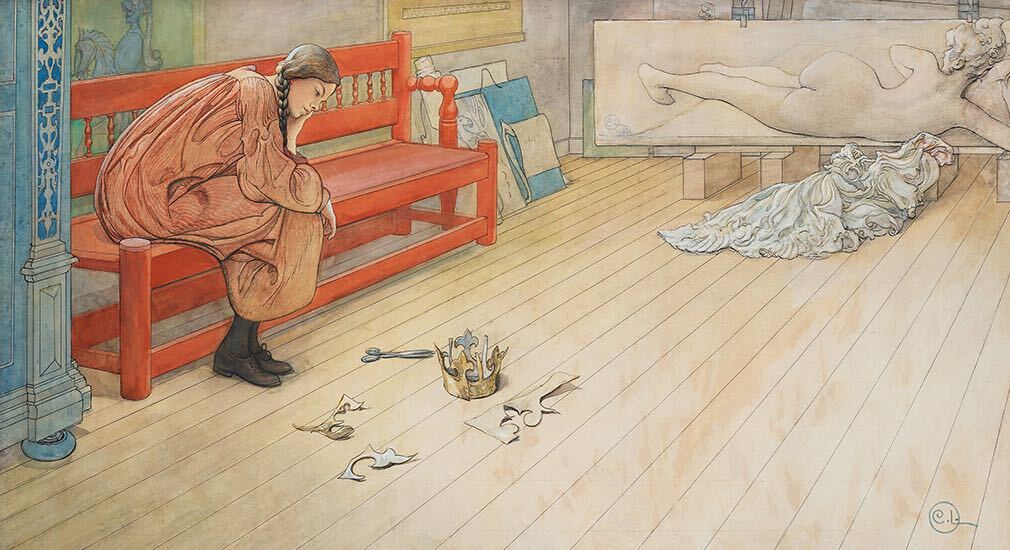Artwork by Carl Larsson at spring's most exceptional auction

To be sold at Important Spring Sale 3–4 June
The girl, submerged in reflections or pondering, is Dagmar Grill. Dagmar, born in 1892, was the daughter of Carl and Karin Larsson's close friends Baltzar and Violet Grill in Djursholm. The beautiful Dagmar was the oldest of the five siblings (Dagmar, Thorsten, Estrid ["Essie"], Ingrid ["Nini"] and Anna-Johanna ["Lillan"]), all of whom came to be depticed by Carl Larsson.
Dagmar was portrayed three times by Carl Larsson. The first one was the 1904 portrait "Dagmar Grill" (charcoal and watercolor 62 x 52 cm, private ownership) which depicts Dagmar standing in profile with narcissus in hand. In the same year, Carl Larsson also performed the present composition, "Theater props", in which Dagmar sits in the pondering on the red long bench in the artist's studio in Sundborn. Behind the long bench is a study, by a rider in armor, of the artist's monumental composition "Gustav Vasa's entrance in Stockholm 1523" (oil on canvas 700 x 1400 cm, 1908, National Museum, Stockholm). Here is also a plaster cast of the relief "Contemporary", which forms the basis of "Contemporary art" (oil on canvas in wall panel with wooden relief 383 x 310 cm, 1888-89, Fürstenbergska gallery, Gothenburg Art Museum) in Carl Larsson's triptych "Renässans-Rokoko -Nutid". Dagmar's resigned pose (it took time for the artist to be satisfied with the composition) in this motif is clarified by a letter from Karin Larsson to his mother on June 26, 1904: "[...] but little Dagmar he has tormented cruelly with model sitting, and is nevertheless not satisfied".
When Dagmar yet again modelled, five years later, however, the situation was quite different as evidenced by the exceedingly idyllic tone of the composition. In "Dagmar Grill" (watercolor, cover white, charcoal and ink 66 x 56 cm, executed approx. 1909, private ownership), which was sold at Bukowskis' Classic autumn auction 2015, we see Dagmar from the side where she sits on a green painted rococo chair in the sparkling garden. To protect against the sun, she wears a large beautiful hat while grasping a branch of oxygen in her hands. As so often in Carl Larsson's compositions, Syrenkvist occupies a central place and thus serves as an eye-catcher for the viewer. There is another subtlety in the motif, where Carl Larsson lets Dagmar's long dark braid at the bottom end with a red bow that echoes the color of the façade in the background.
The other siblings Grill were immortalized in the form of the following motifs: "The Children Grill / Two sisters" (watercolor 72 x 50 cm, 1907, private ownership) where "Nini" and "Essie" were portrayed with mother Violet in the background; "Anna-Johanna Grill" (watercolor 75 x 53 cm, 1913, private ownership) and "Thorsten Grill" (watercolor 67 x 56 cm, 1904, private ownership) which was provided by the artist with the following inscription: "Thorsten Grill, my little friend ... "That the families got along well is also evident in Karin's letter to his mother:" The Children Grill is delightfully rare. Carl has painted them and received a very similar portrait of Thorsten in a couple of hours".
The question is, however, whether Dagmar was not the sibling who came to leave the deepest traces in Swedish art history. Not only through his three individual portraits of Carl Larsson, but also through the family's ties to another of the country's legendary visual artists. Dagmar's parents were also acquainted with Elsa Beskow, also her resident in Djursholm. Since Elsa had only sons, Dagmar was the one available when there was a need for girls as models. Of this, Dagmar (wearing a green coat) will figure in Elsa Beskow's famous illustration for Alice Tegnér's "Sockerbagaren".

Dagmar Grill also came later in life to have strong personal ties to Swedish art history. Her cousin Anna Sebenius (1880-1957) was married to the Austrian architect and designer Josef Frank. Her legendary collaboration with Estrid Ericson at Svenskt Tenn has now come to characterize the world view of the Swedish interior ideal to the same extent as Carl Larsson's watercolors.
In the summer of 1947 Dagmar worked as a physiotherapist at Sätra well and kept in touch with Josef Frank by letter. When he complained about missing architect assignments, Dagmar wanted to encourage him, so she asked him to draw a number of fantasy houses for her. Frank approached the task with eagerness and delivered drawings on, no less than, 13 houses in just a few weeks!
The houses were never to be constructed, but the architects/writers Mikael Bergquist and Olof Michélsen later allowed them to make miniatures of the houses, which were presented at an exhibition at the Architecture Museum in Stockholm. The material was also compiled in a book, "Accidentism", in 2005.
When Anna passed away in 1957, Dagmar moved onto Rindögatan on Gärdet in Stockholm and lived there with Josef Frank until his death in 1967.
"Theater Supplies" / "Theater Foundations" / "Theater Threats" was performed in 1904 by Carl Larsson and will be sold at [Important Spring Sal]e(/auctions/625/home) on June 3-4, and will be displayed May 28-June 2 at Berzelii Park 1 in Stockholm. The watercolor has an exclamation price of 4 000 000 – 5 000 000 SEK.

























